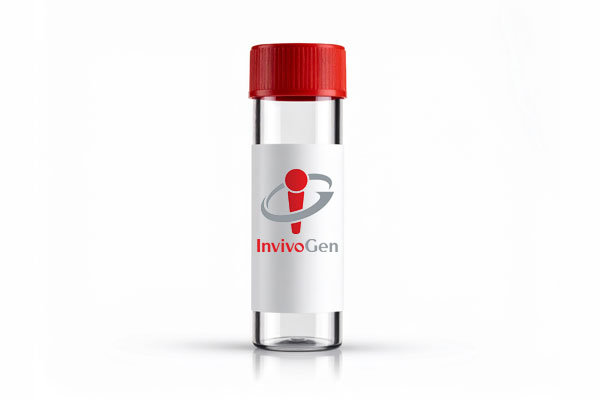
pUNO1-hTLR2-GFP
-
Cat.code:
phtlr2-gfp
- Documents
TLR2-GFP fusion gene was generated by fusing the green fluorescent protein (GFP) gene to the C terminus of human Toll-like receptor 2 (TLR2) gene. This fusion protein can be used to study the localization of TLR2. Transfected cells can be analyzed for GFP expression by flow cytometry and by Western-blotting using GFP antibodies. The TLR2-GFP fusion gene is cloned in the pUNO plasmid under the control of the strong and ubiquitous mammalian promoter EF1α/HTLV.
hTLR2::GFP fusion gene has been fully sequenced, its fluorescence confirmed and its function tested in HEK293 cells coexpressing an NF-κB reporter plasmid (pNiFty-SEAP).
Specifications
Human TLR2::GFP fusion gene (3207 bp)
Selectable with Blasticidin in both E. coli and mammalian cells
Contents
- 20 µg of lyophilized DNA
- 2 x 1 ml blasticidin at 10 mg/ml
![]() Product is shipped at room temperature.
Product is shipped at room temperature.
![]() Lyophilized DNA should be stored at -20°C. Upon receipt, store blasticidin at 4°C or -20°C.
Lyophilized DNA should be stored at -20°C. Upon receipt, store blasticidin at 4°C or -20°C.
![]() Resuspended DNA should be stored at -20°C and is stable for up to 1 year.
Resuspended DNA should be stored at -20°C and is stable for up to 1 year.
![]() Blasticidin is a harmful compound. Refer to the safety data sheet for handling instructions.
Blasticidin is a harmful compound. Refer to the safety data sheet for handling instructions.
Details
Toll-like receptor 2 (TLR2) is involved in the recognition of multiple products of Gram-positive bacteria, mycobacteria and yeast. The first studies reported that TLR2 mediated LPS response but TLR2 has since been shown to confer responsiveness to the lipopeptides present in LPS preparations. However, it seems that some types of LPS can activate TLR2 [1]. TLR2 is known to heterodimerize with other TLRs, a property believed to extend the range of PAMPs that TLR2 can recognize. TLR2 cooperates with TLR6 in the response to peptidoglycan [2] and diacylated mycoplasmal lipopeptide, and assocites with TLR1 to recognize triacylated lipopetides. Furthermore, pathogen recognition by TLR2 is strongly enhanced by CD14.
The hTLR2::GFP fusion gene was generated by fusing at the C terminus of the human TLR2 gene to a GFP variant. A synthetic intron was added between both moieties to increase the activity of GFP. This hybrid protein absorbs blue light (major peak at 480 nm) and emits green light (major peak at 505 nm).
The hTLR2::GFP fusion gene is under the control of the strong and ubiquitous hEF1/HTLV promoter. This composite promoter comprises the Elongation Factor-1α (EF-1α) core promoter [3] and the R segment and part of the U5 sequence (R-U5’) of the Human T-Cell Leukemia Virus (HTLV) Type 1 Long Terminal Repeat [4]. The SV40 late polyadenylation signal enables efficient cleavage and polyadenylation reactions resulting in high levels of steady-state mRNA.
1. Netea MG. et al. (2002). Trends Immunol, 23(3):135-9.
2. Ozinsky A. et al. (2000). Proc Natl Acad Sci U S A, 97(25):13766-71.
3. Kim et al. (1990). Gene 2: 217-223.
4. Takebe et al. (1988). Mol. Cell Biol. 1: 466-472.
DOCUMENTS
Documents
Technical Data Sheet
Safety Data Sheet
Plasmid Map and Sequence
Certificate of analysis
Need a CoA ?